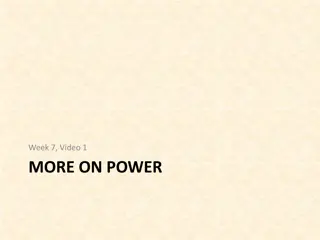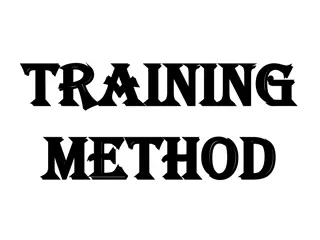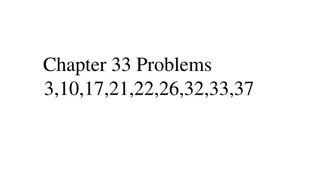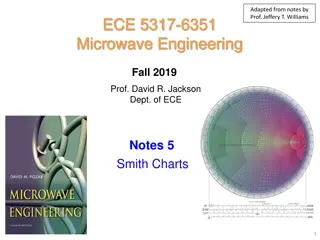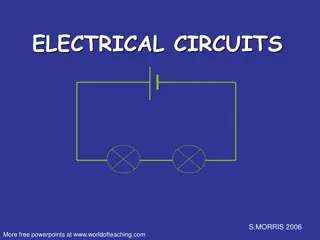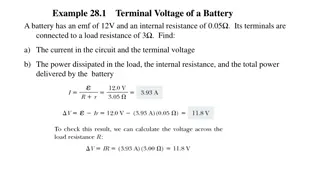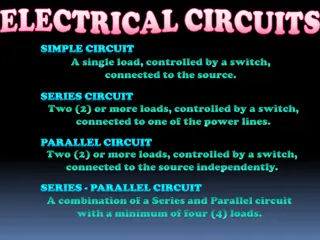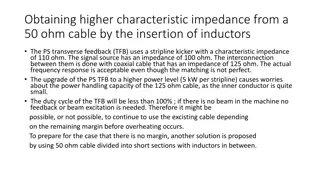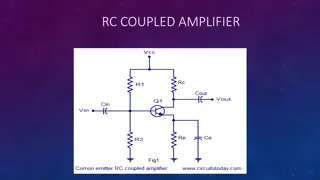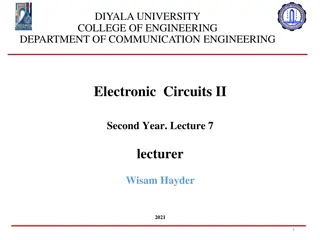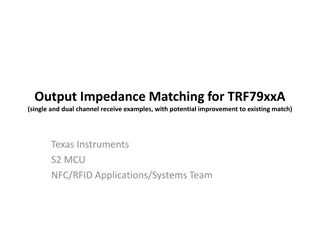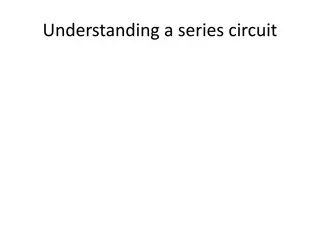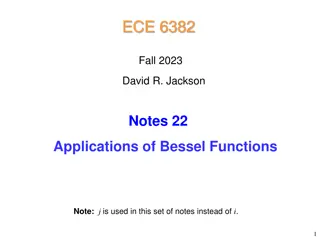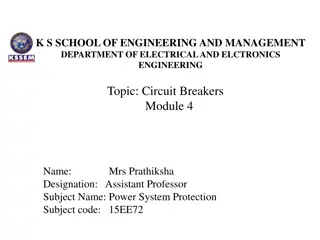Impedance Basics and Circuit Analysis
In this informative content, you will learn about impedance in circuits, including its components, expression methods, series and parallel circuits, and examples of impedance calculations at specific frequencies. Explore topics on reactance, resistance, impedance transformation, and the Smith chart basics to enhance your understanding of circuit characteristics. Discover how impedance affects current flow and voltage relationships, and gain insights into converting parallel circuits to series circuits for impedance evaluation. Dive into practical examples and illustrations to grasp the fundamentals of impedance in electronic circuits effectively.
Download Presentation

Please find below an Image/Link to download the presentation.
The content on the website is provided AS IS for your information and personal use only. It may not be sold, licensed, or shared on other websites without obtaining consent from the author.If you encounter any issues during the download, it is possible that the publisher has removed the file from their server.
You are allowed to download the files provided on this website for personal or commercial use, subject to the condition that they are used lawfully. All files are the property of their respective owners.
The content on the website is provided AS IS for your information and personal use only. It may not be sold, licensed, or shared on other websites without obtaining consent from the author.
E N D
Presentation Transcript
Transmission Lines As Impedance Transformers Transmission Lines As Impedance Transformers Bill Leonard N0CU 285 TechConnect Radio Club 2017 TechFest
Topics Topics Review impedance basics Review Smith chart basics Demonstrate how antenna analyzers display impedance data Demonstrate some important transmission line characteristics
Impedance Impedance Impedance (Z) is a measure of the opposition to current flow Unit of measure = Ohm = Impedance describes a series circuit Impedance has two components: The DC component = Resistance = R (ohms) The AC component = Reactance = X (ohms) Inductive Reactance XL (ohms) = + j2 fL Phase = + 90o (Voltage leads current) XC (ohms) =- j[1/(2 fC)] Phase = - 90o (Voltage lags current) Capacitive Reactance
Impedance Impedance cont d cont d Impedance can be expressed in two ways: 1. Resistance and reactance => Z = R + jX (Complex Number) 2. Magnitude and phase => Z = Z Magnitude of Z (ohms) = Z = R2+X2 Phase of impedance (degrees) = = arctan(X/R) Z R X
Impedance of a Series Circuit Impedance of a Series Circuit Specify a frequency => L C XL XC Step 1 R R X = [XL XC] X XL XC => Z => R R Step 2 1. Z = R + j X = R + j(XL XC) = R + j[(2 fL 1/(2 fC)] 2. Z = Z and
Impedance of a Parallel Circuit Impedance of a Parallel Circuit Z is defined only for a series circuit Must convert a parallel circuit to a series circuit Frequency must be known to do the conversion Both component values change when converted Z = RP + jXP = ? RP XP RPxXP2 RP2 + XP2 RP2x XP RP2 + XP2 RS = XS XS = RS Z = RS + j XS
Example 1: Impedance at 2 MHz Example 1: Impedance at 2 MHz Physical Circuit RP => 796 pF Step 1 100 XP 100 -j100 Equivalent Series Circuit -j50 RP => 1592 pF Step 2 50 XP 100 -j100 Note: Two different circuits have the same impedance at 2 MHz: Z = 50 - j50 = 70.7 @ -45o
Example 1: Impedance at 2 MHz Example 1: Impedance at 2 MHz - - cont d cont d What an MFJ-259B measured at 2 MHz: Physical Circuit Calculated 50 -50 70 -45O 2.6 Measured 56 48 74 40O 2.4 Rs= Xs= Z = Phase = SWR = 796 pF Z => 100 => Z Impedance Meter = 70 70 Note: The MFJ-259B does not display RP, XP, or the sign of a reactance
Transmission Lines Are Lowpass Filters Transmission Lines Are Lowpass Filters Lumped element circuit approximation for lossless transmission line: L . Zo => C L ZOis called the Surge Impedance or Characteristic Impedance of the line When ZLOAD = ZO The line is Matched The input impedance of a transmission line equals ZO and is independent of length ZO ~ L/C Example: Belden RG-58/U (9201) Zo = 52 C = 27 pF/ft L = 94 nH/ft VP = 0.66 ~
When Z When ZLOAD LOAD = Z = ZO O Input impedance of a 50 ohm line when the SWR = 2.0: RLOAD = 100 ohm ZIN => RLOAD = 25 ohm ZIN =>
Example 2 Example 2 What is ZIN at 32 MHz ? 61 inches RG-58 C/U ZIN = 50 50 122 inches RG-58 C/U ZIN = 50 50
Example 2 (contd) Example 2 (cont d) What is ZIN at 32 MHz ? 61 inches RG-58 C/U ZIN = ? 122 inches RG-58 C/U ZIN = ?
Example 2 (contd) Example 2 (cont d) What is ZIN at 32 MHz ? 61 inches RG-58 C/U ZIN = OPEN 122 inches RG-58 C/U ZIN = SHORT
Example 2 (contd) Example 2 (cont d) What is ZIN at 32 MHz ? 61 inches RG-58 C/U ZIN = SHORT 122 inches RG-58 C/U ZIN = OPEN
Example 2 (contd) Example 2 (cont d) The electrical lengths at 32 MHz are: 61 inches = wavelength 122 inches = wavelength Electrical length = VP x physical length VP = velocity of propagation When ZLoad = ZO: ZIN = ZO = ZLoad (for any length of line) When ZLoad = ZO: Transmission lines become impedance transformers When length = nodd x wavelength, transmission lines invert the load impedance Invert => high goes to low and low goes to high Quarter wave transformer: ZIN = (ZO )2/ ZLOAD When length = n x wavelength, transmission lines replicate the load impedance Electrical length = physical length
Quiz: High SWR Quiz: High SWR ? feet transmission line Ant ZIN = Short @ 7 MHz Is the antenna shorted?
Quiz: High SWR Quiz: High SWR cont d cont d ? feet transmission line Ant ZIN = Short @ 7 MHz Is the antenna shorted? Don t know: Need to know the electrical length of the transmission line at 7MHz The antenna could be an open circuit
Vector Network Analyzer: VNA 2180 Vector Network Analyzer: VNA 2180 ZLOAD = 25 SWR = 2.0:1 Rs = 25 Inductance Xs = 0 Capacitance
Example 3: Z Example 3: ZIN IN vs Frequency vs Frequency Use a VNA2180 to plot ZIN vs frequency 61 inches RG-58 C/U ZIN =>
Example 3: Z Example 3: ZIN INvs Frequency (cont d) vs Frequency (cont d) 61 inches RG-58 C/U ZLOAD = OPEN Rs = series resistance Inductance Xs = series reactance Capacitance Repeats every wavelength
VNA 2180 With 25 VNA 2180 With 25 Load Load ZMAG = 25 Inductance ZPhase = 0 Capacitance
Example 3: Plot Z Example 3: Plot ZIN INvs Frequency (cont d) vs Frequency (cont d) 61 inches RG-58 C/U ZLOAD = OPEN ZMAG = Impedance Magnitude Note: Line loss reduces SWR & ZMAG
Example 3: Plot Z Example 3: Plot ZIN INvs Frequency (cont d) vs Frequency (cont d) 61 inches RG-58 C/U ZLOAD = OPEN +90o Impedance Phase Series Resonance Parallel Resonance Inductance Capacitance -90o
Example 3: Plot Z Example 3: Plot ZIN INvs Frequency (cont d) vs Frequency (cont d) 61 inches RG-58 C/U ZLOAD = OPEN Impedance Phase wavelength
Finding the Electrical Length of a Transmission Line Finding the Electrical Length of a Transmission Line 61 inches RG-58 C/U ZLOAD = OPEN ZMAG @ 31.74 MHz Phase Actual physical length = 61.37 inches (assuming VP = 0.66)
Finding the Input Impedance of a Transmission Line Finding the Input Impedance of a Transmission Line ZL ZO
Why Was The Smith Chart Developed? Why Was The Smith Chart Developed? Impedance Looking Into A Transmission Line Hyperbolic Tangent Complex Numbers
Smith Chart Smith Chart
Simplified Smith Chart Simplified Smith Chart Resistance Z = 50 j50 ohms
Normalized Smith Chart Normalized Smith Chart System Impedance Normalized to 1 Z= 1 j1 ohms
SWR vs Transmission Line Length SWR vs Transmission Line Length For Lossless Transmission Line: SWRLOAD SWR2 SWR1 ZLOAD SWRIN => SWR is determined solely by ZO & ZLOAD SWR is constant along a lossless transmission line SWRIN = SWR1 = SWR2 = SWRLOAD
Simplified Smith Chart Simplified Smith Chart Constant SWR Circles Constant SWR Circles 2:1 SWR Circle 1. Adding Length to a Lossless Transmission Line Causes Clockwise Rotation Around a Constant SWR Circle Z changes but SWR is constant One Full Rotation Equals Wavelength Infinite SWR Circle 2. 3. 5:1 SWR Circle
Problem: Antenna Tuner Cant Find A Match Problem: Antenna Tuner Can t Find A Match Many built-in antenna tuners can only match up to a 3:1 SWR External tuners have much better range than built-in tuners It is easier for most antenna tuners to match a high impedance Ex: MFJ-993B spec d matching range is 6 1600 SWR: 1600 => 32:1 6 => 8:1 Many antenna tuners become very lossy at very low impedances Obtaining a match is only part of the solution Example: Palstar AT-Auto Loss matching 6.25 ohms on 160M is 42%! (QST Aug 2006)
Problem: Antenna Tuner Cant Find A Match Problem: Antenna Tuner Can t Find A Match Many built-in antenna tuners can only match up to a 3:1 SWR External tuners have much better range than built-in tuners It is easier for most antenna tuners to match a high impedance Ex: MFJ-993B spec d matching range is 6 1600 SWR: 1600 => 32:1 6 => 8:1 Many antenna tuners become very lossy at very low impedances Obtaining a match is only part of the solution Example: Palstar AT-Auto Loss matching 6.25 ohms on 160M is 42%! (QST Aug 2006) Common recommendation: add a short length of coax to reduce the SWR
Example 4: Antenna Matching Problem Example 4: Antenna Matching Problem Problem: Antenna Tuner Can t Find A Match At 14.0 MHz: ZIN = 10 + j1.3 SWR = 5.0:1 => ZL = 250 Zo = 50 => ZIN = 50 SWR = 1.0:1 Antenna Tuner => ZL = 250 Zo = 50
Example 4: Antenna Matching Problem (contd) Example 4: Antenna Matching Problem (cont d) Z = 10+j1.3 SWR = 5.02:1
Example 4: Antenna Matching Problem (contd) Example 4: Antenna Matching Problem (cont d) Z = 10+j1.3 SWR = 5.02:1
Example 4: Antenna Matching Problem (contd) Example 4: Antenna Matching Problem (cont d) Z = 55+j92 SWR = 4.9:1 Additional 8.2 ft of RG-8A Cable Match should be possible due to higher impedance SWR didn t change! The loss in the tuner should be lower
Example 4: Antenna Matching Problem (contd) Example 4: Antenna Matching Problem (cont d) Simple (Single Band) Solution: 8.2 ft RG-8A ZIN = 55+ j92 SWR = 4.9:1 => ZL = 250 Zo = 50 => 124 pF = -j92 @ 14MHz 8.2 ft RG-8A 124 pF ZIN = 55 + j0 SWR = 1.1:1 => ZL = 250 Zo = 50
ARRL Transmission Line for Windows (TLW) ARRL Transmission Line for Windows (TLW) Free software with ARRL Antenna Book
Example 5: Antenna Tuning Example 5: Antenna Tuning Should an antenna be tuned to resonance, or for lowest SWR?
Example 5: Antenna Tuning Example 5: Antenna Tuning cont d Should an antenna be tuned to resonance, or for lowest SWR? cont d 5 Band Hex Beam: 20 M SWR Phase Resonance2 Resonance1
Example 5: Antenna Tuning Example 5: Antenna Tuning cont d cont d 40 M Dipole SWR Phase
Example 5: Antenna Tuning Example 5: Antenna Tuning cont d cont d 40 M Dipole at input to transmission line 40 M Dipole SWR SWR Phase Phase Is the antenna no longer resonant?
Example 5: Antenna Tuning Example 5: Antenna Tuning cont d cont d 40 M Dipole 40 M Dipole at input to transmission line
Example 5: Antenna Tuning Example 5: Antenna Tuning cont d cont d 40 M Dipole 40 M Dipole at input to transmission line The antenna is still resonant The antenna System is not resonant?
Example 5: Antenna Tuning Example 5: Antenna Tuning cont d cont d SWR Tuning for minimum SWR is usually the best approach Resonance: Is not required for good antenna performance May not occur at the same frequency as minimum SWR SWR affects transmitter output, not resonance
SWR vs Transmission Line Loss SWR vs Transmission Line Loss Line Loss SWR => Open/Short Loss (dB) 0 1 2 3 Infinite Measured SWR Infinite 8.8 4.4 3.0 1.0 (75 ft RG-58A @ 28 MHz) Transmission line loss reduces measured SWR
Summary Summary Make sure you understand the impedance measurement you are getting from your antenna analyzer When ZLOAD = ZO, transmission lines can become impedance transformers This behavior can either be helpful or harmful The Smith chart: Is a good learning tool Is not the easiest way to solve impedance problems Adding a short length of transmission line might help an antenna tuner achieve a match Because it raises the impedance (it does not lower the SWR!) It is usually better to tune an antenna for best SWR rather than resonance Transmission line loss lowers the measured SWR





